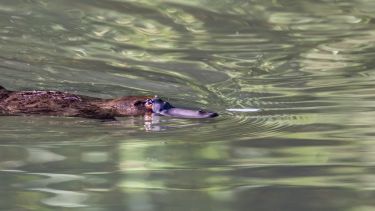
Environment
On the DNA trail of the platypus

As a global community, we must work beyond our national borders to protect threatened species and maintain biodiversity
Published 29 April 2020
During a global extinction crisis and rapidly changing world, many nations are now looking to harden their borders to restrict the movement of people.
But not all species recognise political boundaries, and neither do the threats to their existence.

Different national conservation priorities can mean a species may be protected in one country but hunted over the border; while physical barriers, including border fences and vegetation clearing, impacts their connectivity, access to critical resources and can cause injuries or isolation.
Our research shows that over half the world’s terrestrial species — birds, mammals and amphibians — and 21 per cent of threatened terrestrial species have ranges that cross a national border.

Environment
On the DNA trail of the platypus
These threatened transboundary species are primarily concentrated in Asia, with smaller hotspots in eastern equatorial Africa, Central America and South America.
With extinctions now occurring up to 100 times higher than the background rate, the global community must look beyond political borders and work in collaboration with neighbouring governments, institutions and communities to implement safeguards for biodiversity.
And coordinated planning for conservation is vital to ensure the continued survival of these threatened species.
Relationships between neighbouring countries can be incredibly complex, and the drivers for successfully implementing and sustaining a transboundary conservation initiative are not currently well understood.
Differing governance capacities, historical relations and ever-increasing development pressures present significant challenges to nations when collaborating for conservation.
We’ve combined these factors to produce an index of global transboundary conservation feasibility. Regions with high feasibility scores were clear ‘low-hanging fruit’ for transboundary conservation (areas such as Fennoscandia, the United States and Canada).

Although these areas typically had fewer threatened transboundary species, it is still important to see collaborative conservation efforts in these regions.
North America has many species with large ranges, including grey wolves, grizzly bears and wolverines – and they require large-scale management planning.
The Yellowstone to Yukon transboundary initiative, which crosses the USA-Canada border, adopts a range of conservation mechanisms, including private land and Indigenous protected areas, alongside areas preserved to sustain landscape connectivity.

Sciences & Technology
How do we protect our unique biodiversity from megafires?
Partnerships and strong community engagement allows the program to influence policy decisions and action strategies, reducing habitat fragmentation in priority land for large-ranging species.
In Asia, the island of Borneo, shared by three nations, is a hotspot for threatened species and has a relatively high potential for implementing transboundary conservation across its mountainous interior.
Currently, human pressure remains low, and this relatively intact landscape is critical for threatened mammals, like the Borneo Bay Cat (Catopuma badia) and Orangutans (Pongo pygmaeus), along with many forest-dependent birds.
This potential has been recognised with the Heart of Borneo Initiative, which indicates some progress in-principal towards establishing sustainable management in the island’s interior.
This agreement between Malaysia, Indonesia and Brunei to sustainably manage the largest intact rainforest in Southeast Asia is an important step, but a formally designated and committed transboundary response is still needed to ensure that the region’s unique biodiversity is preserved.

Other regions, such as Central Africa, face additional challenges as governance capacities can be low, with complex relationships between neighbours as a result of sporadic national and cross-border disputes.
One success story to emerge from this area is the Greater Virunga Transboundary Collaboration, which spans the border regions of Uganda, Rwanda and the Democratic Republic of Congo.

Sciences & Technology
The wicked risks of biosecurity
Even throughout periods of civil conflict and cross-border disputes, the landscape has been preserved through the collective action of local field personnel and regional representatives.
Information sharing, monitoring, and communication continued throughout conflict periods which shows the remarkable power of locally-established institutions in conservation.
The International Gorilla Conservation Programme was initiated and enacted with Protected Area Authorities and field personnel resulting in concrete achievements in population growth, establishing coordinated patrols, population censuses and anti-poaching activities – all while conflict lingered in the region.
Individual nations still have an immense responsibility to protect endemic species, but the biodiversity crisis cannot be addressed by individual nations acting alone.
International treaties are increasingly advocating for coordinated cross-border approaches to respond to these threats, but widespread action remains elusive.
As a global community, we must be prepared to work beyond national borders to successfully avert the loss of our biodiversity.
Banner: Young rhinoceros/ Getty Images